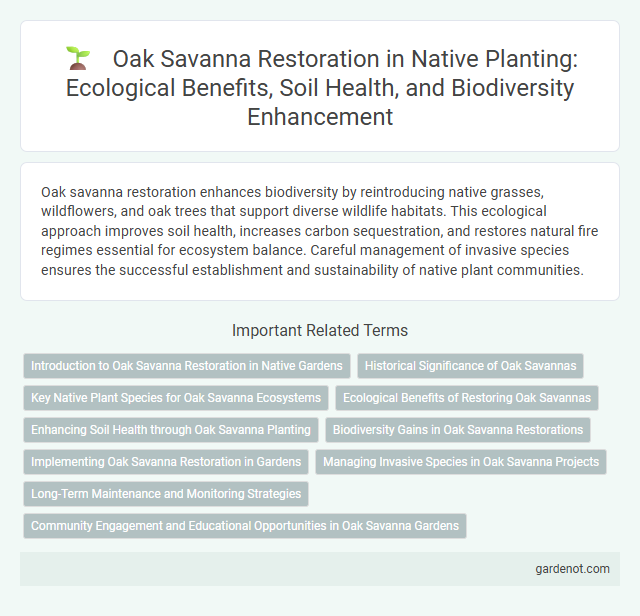Oak savanna restoration enhances biodiversity by reintroducing native grasses, wildflowers, and oak trees that support diverse wildlife habitats. This ecological approach improves soil health, increases carbon sequestration, and restores natural fire regimes essential for ecosystem balance. Careful management of invasive species ensures the successful establishment and sustainability of native plant communities.
Introduction to Oak Savanna Restoration in Native Gardens
Oak savanna restoration in native gardens revitalizes ecosystems by reintroducing majestic oak trees and diverse native understory plants. This habitat supports pollinators, birds, and soil health through deep-rooted grasses, wildflowers, and scattered oaks characteristic of historic savannas. Incorporating fire-adapted species and mimicking natural disturbance cycles ensures long-term ecological balance and biodiversity.
Historical Significance of Oak Savannas
Oak savannas, once spanning millions of acres across North America, served as vital ecosystems supporting diverse flora and fauna, including numerous native plant species and wildlife. These ecosystems played a crucial role in Indigenous cultures, providing resources for food, medicine, and materials, and shaping traditional land management practices through controlled burns. Restoring oak savannas aids in preserving biodiversity, protecting soil health, and maintaining the ecological balance integral to historical landscapes.
Key Native Plant Species for Oak Savanna Ecosystems
Oak savanna ecosystems rely heavily on key native plant species such as Quercus alba (white oak), Andropogon gerardii (big bluestem), and Solidago nemoralis (gray goldenrod) to maintain ecological balance and biodiversity. These species provide critical habitat, soil stabilization, and support pollinator populations essential for ecosystem health and resilience. Restoration efforts prioritize reintroducing these endemic plants to reestablish native plant communities and promote long-term ecosystem sustainability.
Ecological Benefits of Restoring Oak Savannas
Restoring oak savannas enhances biodiversity by providing critical habitats for numerous native plant and animal species, including pollinators and ground-nesting birds. The reestablishment of deep-rooted oaks improves soil health through increased organic matter and nutrient cycling, supporting overall ecosystem resilience. Oak savanna restoration also contributes to carbon sequestration, mitigating climate change impacts by storing significant amounts of carbon in both vegetation and soil.
Enhancing Soil Health through Oak Savanna Planting
Oak savanna planting significantly enhances soil health by increasing organic matter and promoting microbial diversity vital for nutrient cycling. The deep root systems of native oak savanna species improve soil structure, increase water infiltration, and reduce erosion. Restoring oak savanna ecosystems supports a balanced nutrient profile, crucial for long-term soil fertility and ecosystem resilience.
Biodiversity Gains in Oak Savanna Restorations
Oak savanna restoration significantly enhances biodiversity by reintroducing native plant species, which create diverse habitats for wildlife such as pollinators, birds, and small mammals. Restored oak savannas increase species richness and support rare plant populations, including native grasses and forbs crucial for ecosystem resilience. These efforts promote ecological balance by reestablishing old-growth oak trees alongside a rich understory, fostering long-term habitat stability.
Implementing Oak Savanna Restoration in Gardens
Implementing oak savanna restoration in gardens involves selecting native oak species such as Quercus macrocarpa and planting understory natives like prairie grasses and wildflowers to recreate the savanna ecosystem. Maintaining open canopy conditions through regular thinning and controlled burns encourages biodiversity and supports wildlife habitats. Soil preparation and ongoing management practices are crucial for establishing resilient oak savanna landscapes that enhance local ecological balance.
Managing Invasive Species in Oak Savanna Projects
Effective management of invasive species is crucial for successful oak savanna restoration, as these non-native plants outcompete native grasses and wildflowers, disrupting ecosystem balance. Techniques such as targeted herbicide application, prescribed burning, and manual removal help control invasive species like buckthorn and garlic mustard. Maintaining native plant diversity supports local wildlife and restores natural fire regimes vital for oak savanna health.
Long-Term Maintenance and Monitoring Strategies
Long-term maintenance and monitoring strategies for oak savanna restoration emphasize periodic prescribed burns to mimic natural fire regimes, which promote native species diversity and control invasive plants. Regular assessments of soil health, plant community composition, and wildlife populations help track ecosystem recovery and guide adaptive management decisions. Integrating citizen science and remote sensing technologies enhances data collection efficiency and ensures sustained restoration success over decades.
Community Engagement and Educational Opportunities in Oak Savanna Gardens
Community engagement in oak savanna restoration fosters stewardship by involving local volunteers in planting native grasses, wildflowers, and oak seedlings. Educational programs in oak savanna gardens provide hands-on learning experiences that enhance understanding of ecosystem functions, biodiversity, and conservation strategies. These initiatives strengthen community connections to native landscapes while promoting sustainable restoration practices.
Oak savanna restoration Infographic

 gardenot.com
gardenot.com